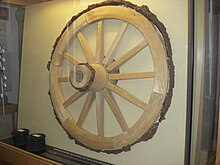45:
52:
29:
209:
at the site. He subsequently recorded a barrow approximately 20 feet (6.1 m) in width and 4–5 feet (1.2–1.5 m) in height containing a mass of corroded iron which was subsequently identified as a chariot wheel. Kirk returned in 1935 to undertake a more complete excavation with A.E.
214:
in 1959. Stead's report showed that the chariot burial was in a square-barrow, two iron wheels were excavated in their upright positions, and an iron bridle bit was also discovered. The wheels and bridle from this excavation were originally displayed in the
44:
405:
234:
in 1972. A pair of prehistoric linear boundaries, each several hundred metres in length, surround the site on its north and eastern edges.
390:
395:
362:
331:
99:
357:
326:
230:
at the site dating to the Late
Neolithic to the Late Bronze Age periods, not investigated by Kirk and Grabham, was
358:"Two prehistoric linear boundaries with associated features, 680m ESE and 880m NNE of Pexton Moor Farm (1020699)"
198:
400:
267:
162:
231:
216:
353:
322:
220:
186:
174:
134:
75:
166:
79:
60:
28:
182:
205:. Kirk recorded that a gamekeeper on the site had discovered fragments of iron whilst
384:
243:
202:
178:
150:
210:
Wellsford; she retained notes on the excavations which were eventually published by
170:
227:
114:
101:
211:
206:
327:"Round cairn on Pexton Moor, 150m north east of Pexton Moor Farm (1020518)"
169:
containing a prehistoric cemetery. It is located at the western edge of
288:
Stead, I.M. (1959). "A Chariot Burial on Pexton Moor, North Riding".
33:
A chariot wheel from Pexton Moor on display in the
Yorkshire Museum.
197:
The site comprises a single chariot burial excavated in 1911 by
272:
Annual Report of the
Yorkshire Philosophical Society for 1911
146:
141:
130:
93:
85:
70:
16:Archaeological site in North Yorkshire, England
8:
21:
59:Map showing the location of Pexton Moor in
27:
20:
268:"The Opening of a Tumulus near Pickering"
219:. They are now in the collection of the
283:
281:
255:
261:
259:
7:
185:prevalent in the region during the
51:
363:National Heritage List for England
332:National Heritage List for England
14:
50:
43:
406:1911 archaeological discoveries
1:
422:
391:History of North Yorkshire
396:Iron Age sites in England
38:
26:
115:54.256356°N 0.69981515°W
177:. It forms part of the
120:54.256356; -0.69981515
307:Stead, I. M. (1979).
266:Kirk, J. L. (1912).
311:. Yorkshire Museum.
163:archaeological site
111: /
23:
217:York Castle Museum
181:of inhumation and
309:The Arras Culture
226:A well-preserved
156:
155:
413:
375:
374:
372:
370:
354:Historic England
350:
344:
343:
341:
339:
323:Historic England
319:
313:
312:
304:
298:
297:
285:
276:
275:
263:
221:Yorkshire Museum
187:British Iron Age
175:Thornton-le-Dale
126:
125:
123:
122:
121:
116:
112:
109:
108:
107:
104:
76:Thornton-le-Dale
54:
53:
47:
31:
24:
421:
420:
416:
415:
414:
412:
411:
410:
401:Chariot burials
381:
380:
379:
378:
368:
366:
352:
351:
347:
337:
335:
321:
320:
316:
306:
305:
301:
296:(131): 214–216.
287:
286:
279:
265:
264:
257:
252:
240:
195:
167:North Yorkshire
119:
117:
113:
110:
105:
102:
100:
98:
97:
80:North Yorkshire
66:
65:
64:
63:
61:North Yorkshire
57:
56:
55:
34:
17:
12:
11:
5:
419:
417:
409:
408:
403:
398:
393:
383:
382:
377:
376:
345:
314:
299:
277:
254:
253:
251:
248:
247:
246:
239:
236:
194:
191:
183:chariot burial
154:
153:
148:
144:
143:
139:
138:
132:
128:
127:
95:
91:
90:
87:
83:
82:
72:
68:
67:
58:
49:
48:
42:
41:
40:
39:
36:
35:
32:
15:
13:
10:
9:
6:
4:
3:
2:
418:
407:
404:
402:
399:
397:
394:
392:
389:
388:
386:
365:
364:
359:
355:
349:
346:
334:
333:
328:
324:
318:
315:
310:
303:
300:
295:
291:
284:
282:
278:
273:
269:
262:
260:
256:
249:
245:
244:Arras Culture
242:
241:
237:
235:
233:
229:
224:
222:
218:
213:
208:
204:
203:Oxley Grabham
200:
192:
190:
188:
184:
180:
179:Arras Culture
176:
172:
168:
164:
160:
152:
151:Arras Culture
149:
145:
140:
136:
133:
129:
124:
96:
92:
88:
84:
81:
77:
73:
69:
62:
46:
37:
30:
25:
19:
367:. Retrieved
361:
348:
336:. Retrieved
330:
317:
308:
302:
293:
289:
271:
225:
196:
171:Dalby Forest
158:
157:
18:
228:round cairn
173:, north of
159:Pexton Moor
118: /
94:Coordinates
22:Pexton Moor
385:Categories
250:References
103:54°15′23″N
369:24 August
338:24 August
290:Antiquity
232:scheduled
212:Ian Stead
207:rabbiting
199:John Kirk
106:0°41′59″W
89:Yorkshire
274:: 57–62.
238:See also
193:The site
147:Cultures
137:Cemetery
135:Iron Age
71:Location
142:History
161:is an
86:Region
74:near
371:2021
340:2021
201:and
131:Type
165:in
387::
360:.
356:.
329:.
325:.
294:33
292:.
280:^
270:.
258:^
223:.
189:.
78:,
373:.
342:.
Text is available under the Creative Commons Attribution-ShareAlike License. Additional terms may apply.

